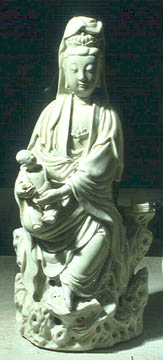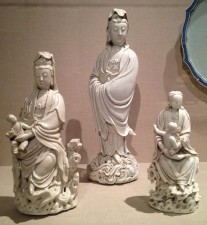
Unknown
Chinese, Fujian province
Bodhisattva Guanyin Presenting a Boy, 17th c. CE, or 18th, Qing dynasty
Dehua ware, porcelain with white glaze and stamped seal
13 1/2 x 6 x 4 3/4 in.
SBMA, Gift of Mr. and Mrs. E.A. Bryant
1970.8
RESEARCH PAPER
Although pottery has been used for ages almost everywhere by the human race, it is stoneware and porcelain, which are impervious and strong, that are purely a Chinese invention. As early as the 5th and 6th century BC, towards the end of the Chou dynasty, Chinese potters found a method of firing kilns that produced high temperatures. This is very important for producing stoneware and porcelain.
Porcelain gradually evolved in China, probably during the Tang dynasty. With time, the potters’ creativity reached such a level that it became a fine art. The evolution from earthenware to porcelain came by a process of refining materials and the manufacturing techniques. This true porcelain, sometimes called hard porcelain, was a combination of kaolin, or China clay, and petuntse, also known as feldspar of China stone. The Chinese called these ingredients the body and the bone of porcelain. When fired at high temperatures, the paste becomes like glass, with a surface that is hard to scratch, even with a steel file. The glaze and the body blend so intimately that they seem to be part and parcel of each other.
In the 17th century, an independent kiln in the Te-hua region of Fukien province produced very high quality white porcelain, known by its French name, Blanc de Chine. The high-grade clay--kaolin--found locally in the Te-hua region, made the high quality production possible. Blanc de Chine is a highly vitrified material, very translucent, and covered with a smooth and mellow glaze, with a distinctive character and great beauty. The shades of the glaze can be from ivory or creamy white to the color of skim milk. Production of Te-hua Blanc de Chine began in the 17th century and continued almost unaltered even beyond the 18th century. Blanc de Chine became so popular that it was later copied in Germany, France, England, and Austria. However, they used alternate materials, as the fine clays of kaolin and petentse, used by the Chinese are not found in Europe.
The Te-hua porcelains are best known for the religious figures of Buddhist and Taoist gods, and their disciples. The SBMA seated Bodhisattva Guan Yin (Kuan Yin) with child is a fine example of a Te-Hua Blanc de Chine figure.
The figure is hollow. It may have been molded and the details worked by hand. The head may even have been made separately. The early history of the piece is unknown and it is not known whether it was made for domestic consumption or for export.
Bodhisattva Guan Yin is the goddess of mercy, compassion, and the giver of children. She also protects childbirth. The goddess is sitting peacefully with a child on her right thigh. Her left foot is bare, and the right foot is resting on her left thigh. She is draped elegantly in white and the drape has many soft folds. Her stylized hair, though partially covered, gives the impression of a crown. Her jewelry is very simple: one bangle on each hand and a necklace with a lotus pendent resting on her heart. Her tiara also has a lotus motif. In Buddhism, the lotus symbolizes purity and the heart is the seat of compassion.
Bodhisattva Guan Yin’s hands are around the child in a relaxed manner. The child is wearing pants, which are held up by a halter going around his neck. There is a large round opening in the seat for his toilet purposes. His feet are covered--perhaps with silk bootees. We can tell that the child is a boy from the Chinese traditional cut of his hair. He is sitting very comfortably on the Bodhisattva Guan Yin’s lap, leaning slightly toward her right arm. His left hand is touching the goddess’ garment on her left side.
Indeed, they look like the Madonna and child. A closer look, however, will show that everything from hairstyles, clothes, jewelry, as well as features is typically Chinese.
Condition and restoration (from the Museum’s file)
Three fractures (turned brown) in the back of the upper torso, lengths vary from 1” to 3”. There are scattered black pit marks across the back, which may be part of the original condition. Tips of fingers of the Bodhisattva Guan Yin’s left hand are broken off, the thumb and forefinger of the right hand are extensively broken off, and the wrist is cracked and turned brown. The right forearm of the child is broken off.
Prepared for SBMA Docent Council by Sneh Singh, March 1997
Website preparation by Eunice Drell, January, 2005
BIBLIOGRAPHY
Chinese Pottery and Porcelain, R. L. Hobson, Volume II
Chinese Art, Lion-Goldschmidt, Daisy and Moreau-Gobaard, Jean-Claude, Universe Books, 1960
A History of far Eastern Art, Lee, Sherman E, Harry N. Abrams Inc., 1982
POSTSCRIPT
The 2012 re-installation of the Asian Galleries reflects an updated title and spelling of this object. The 1997 research paper reflects past curatorial preferences:
Seated Bodhisattva Guan Yin with Child = Bodhisattva Guanyin Presenting a Boy
Te-hua = Dehua
Fukien province = Fujian province
Guan Yin (Kuan Yin) = Guanyin

COMMENTS
Blanc de Chine
Blanc de Chine is a fine, white, vitrified porcelain of great beauty and luster. It was first made in Tehua in the province of Fukien, China, during the fifteenth century--early Ming Dynasty. The pieces were prized for their beauty of form and luster of the glaze. The ware is plain white; and when it has a rosy tinge (very rare), it is especially prized. It is decorated only with incised, impressed, molded, or applied ornaments of rather formal character.
Cups were made shaped like rhinoceros horns, bowls, censers, jardinières, brush pots and small figures of Buddhist and Taoist deities and disciples. (The Goddess of Mercy, Guan Yin, was a favorite Buddhist deity, and many figures of her were made). In the later years of the eighteenth century, 1750-1780, figures of European and Englishmen dressed in their European style clothing were made and exported.
The chief characteristic of Blanc de Chine, aside from its whiteness, is the close bond between the glaze and the biscuit, or body of the pieces. Upon firing, the glaze seemed to sink into the biscuit and become one with it in a way unmatched by any other porcelain. The effect is of softness, and glaze is very smooth to the touch.
The shades of white of the glaze vary from piece to piece, from the blue-white of skimmed milk to cream color. When the white was tinged with rose, which was very rare, the piece was very highly prized. The subtle beauty of the all-white pieces lies in their shape or form.
The clay for the body of the Tehua ware, as Blanc de Chine was sometimes called, before the French wrote about it in their language, was dug from the top of a four hundred foot mountain behind the Tehua kilns. The potters prepared it for use very carefully. The clay was pounded and pulverized, mixed with water, dried, and pulverized again, which made a very fine material for the body of the pieces. But if the material was worked too thin, it was likely to lose its shape on firing in the kiln, and if it was worked too thick, it was likely to crack. At first, the ware was very expensive, but by seventeen hundred it was widely distributed and no longer so expensive.
Blanc de Chine was never intended to be decorated with enamel colors, as other white porcelain from China was decorated, in the eighteenth century some of it was decorated superfluously and “impertinently” (the adverb used by Maria Penskalla) decorated by china painters in England and on the Continent. This over-decorated ware was called “clobbered.”
Simple Blanc de Chine figures from the seventeenth century were exported to Europe in large quantities and were in the collection of Royalties such as the Dresden collection of Augustus the Strong, or the Rosenberg collection in Denmark.
At the end of the eighteenth century, the production of Blanc de Chine declined and came to a stop. Since 1950, however, the Tehua porcelain industry has been reactivated and Blanc de Chine is made for export at Fu-Chou (Foo-Chow).
Form the SBMA Docent Council Asian Arts Study Group, October 25, 1995
Website preparation by Eunice, Drell, January 2005
BIBLIOGRAPHY
Battie, David, ed., Sotheby’s concise Encyclopedia of Porcelain, Little Brown, Boston, Toronto, London, 1990
Hobson, R. L., Chinese Pottery and Porcelain, Dover, NY, 1976
Palmer, Arlene M., A Winterthur Guide to Chinese Export Porcelain; Crown Publishers, Inc., Charlton, .Mass. 1976
Penskalla, Marcia, Magic Blanc de Chine: A handbook for the collector, Interbook International, Shiedam, The Netherlands, 1980
Victoria and Albert Museum Far Eastern Series, Chinese Ceramics: Porcelain of the Qing Dynasty, 1644-1911, 1986
SBMA CURATORIAL LABELS
White Porcelain
During the Ming and Qing dynasties (1368-1911) an independent kiln in Dehua in the Fujian province of southern China became famous for producing white porcelain figurines and vessels popularly known today by their French name, Blanc de Chine. The figurines were first molded and then individually finished by hand. Small holes were left in the ears and mouths of the vessels to permit gases to escape during firing. Blanc de Chine became so popular in Europe that it was later copied in Germany, Austria, France and England.
Asian Gallery, 2012
